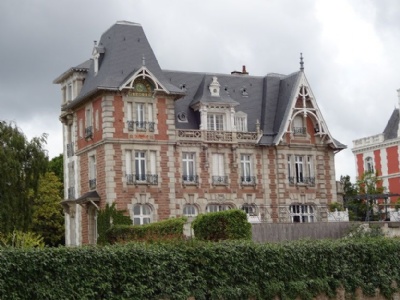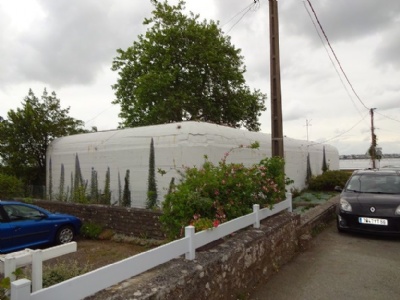Lorient – Kerneval
In November 1940, Admiral Karl Doenitz, the head of the submarine fleet, moved his headquarters from Paris to Lorient. He placed his Headquarters in a classy villa called Kerneval, lying on the other side of the bay opposite the base. In March 1942, the headquarters was moved back to Paris because. This because it was to vulnerable and to unprotected against a possible allied commando raid similar to that raid against the base in Saint Nazaire.
Admiral Karl Doenitz served in the imperial submarine fleet during the First World War. After the war, he was released from prison, but returned to serve in the German navy. When Hitler gained power in 1933 and subsequently began to rearm, Doenitz was appointed head of the German submarine fleet and responsible for its reconstruction. When the war broke out in 1939, he only had a few submarines in serrvice. But some spectacular missions, including the sinking of the British battleship Royal Oak in October 1939, convinced Hitler that the submarines had potential.
The main task of the submarines was to patrol the northern Atlantic and the Arctic in search of convoys transporting war materials and supplies on their way to Britain and the Soviet Union. In 1941 and 1942, the German submarines were very successful in sinking cargo ships. British prime minister, Winston Churchill, was seriously concerned that the submarines would crack Britain. But an improved allied defence technique allowed the convoys to be better protected from 1943 and onwards. Then the tide turned over to the advantage of the Allies. In 1943, Doenitz was appointed commander of the entire German navy (Kriegsmarine).
Doenitz remained faithful to Hitler throughout the war, and in the political will that Hitler established shortly before he committed suicide, Doenitz was appointed president and thus the supreme leader of Germany. One likely reason why Hitler named Doenitz his successor may be that Hitler considered the navy to be the only branch of arms that did not let him down. The state he inherited was not long-lived and he ended up in British captivity, was one of the defendants in the main trial in Nuremberg, was sentenced to 10 years in prison in Spandau, Berlin. He was released in October 1956. Doenitz then lived a withdrawn life until his death in 1980. Both sons of Doenitz served in the submarine fleet and died in 1943 and 1944 respectively, when the submarines they served on were sunk.
Current status: Preserved (2017).
Address: Place de Kerneval, 56260 Larmor-Plage.
Get there: Car.
Follow up in books: Padfield, Peter: Donitz: The Last Führer (1987).



Villa Kerneval is private property and can only be seen from the outside. There are several bunkers nearby, some of them are used for various purposes while others are empty and closed. In addition to the bunkers above ground there are also bunkers beneath ground. These are in quiet good condition but are closed for visitors. At least for those who doesn’t have the right contacts.